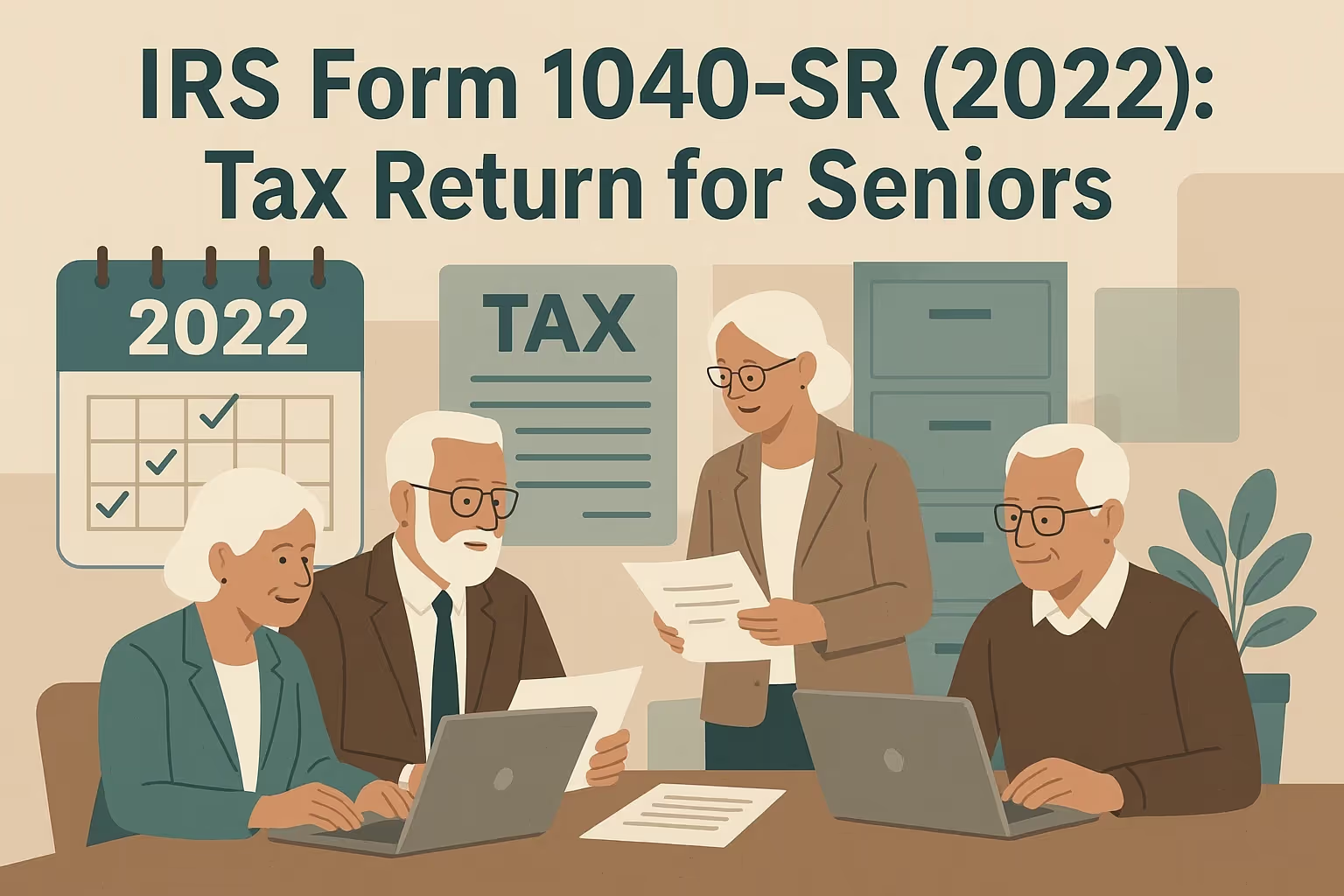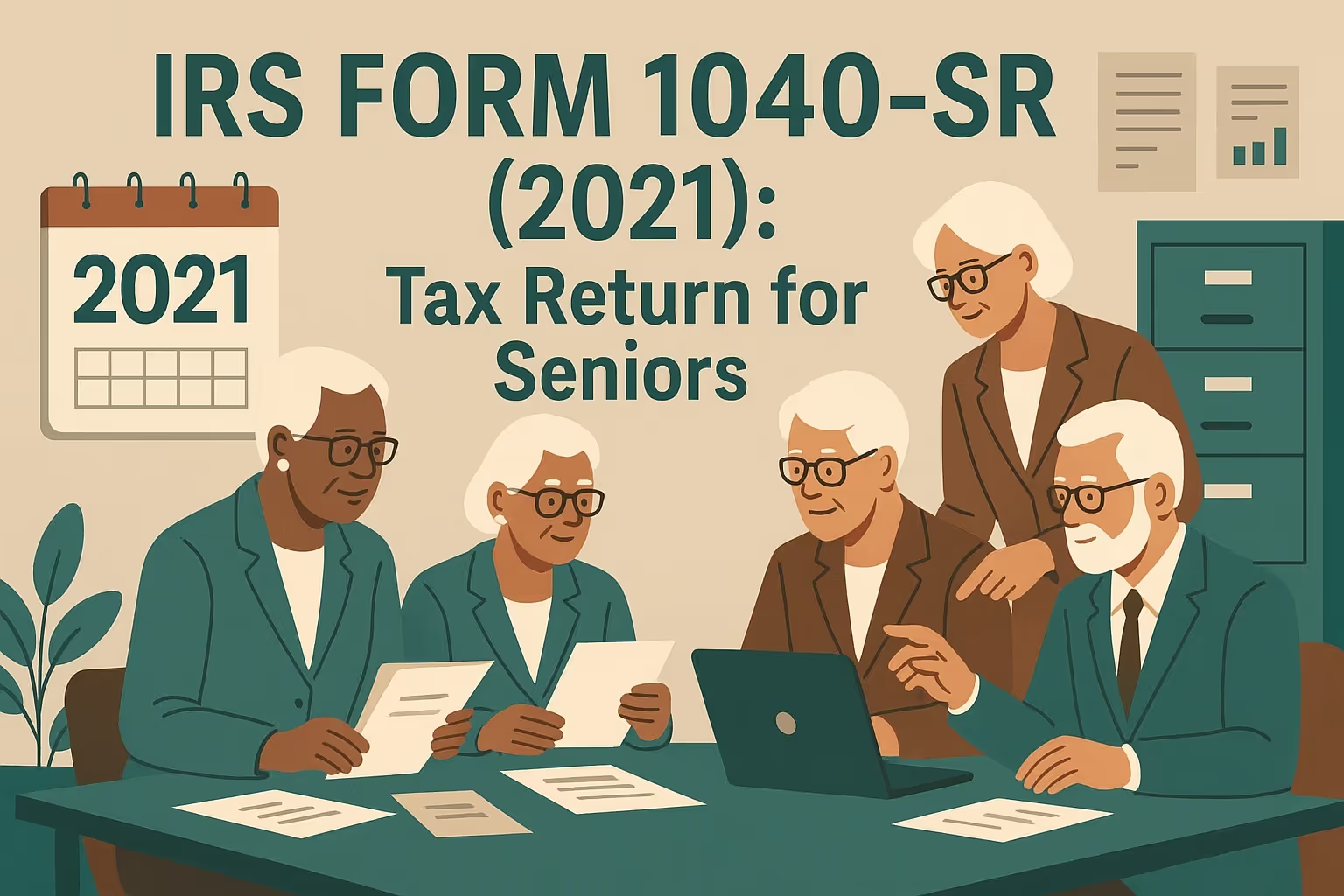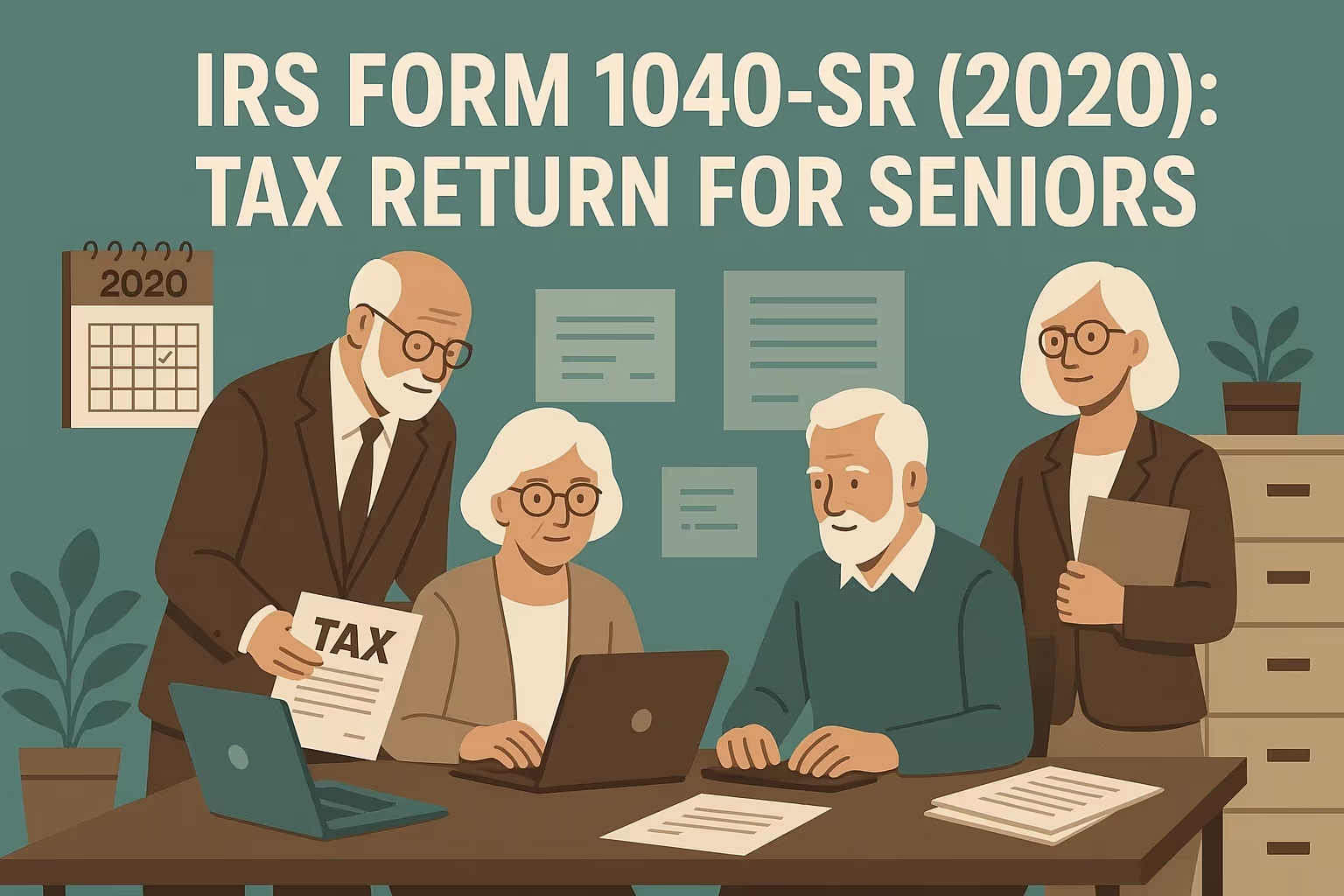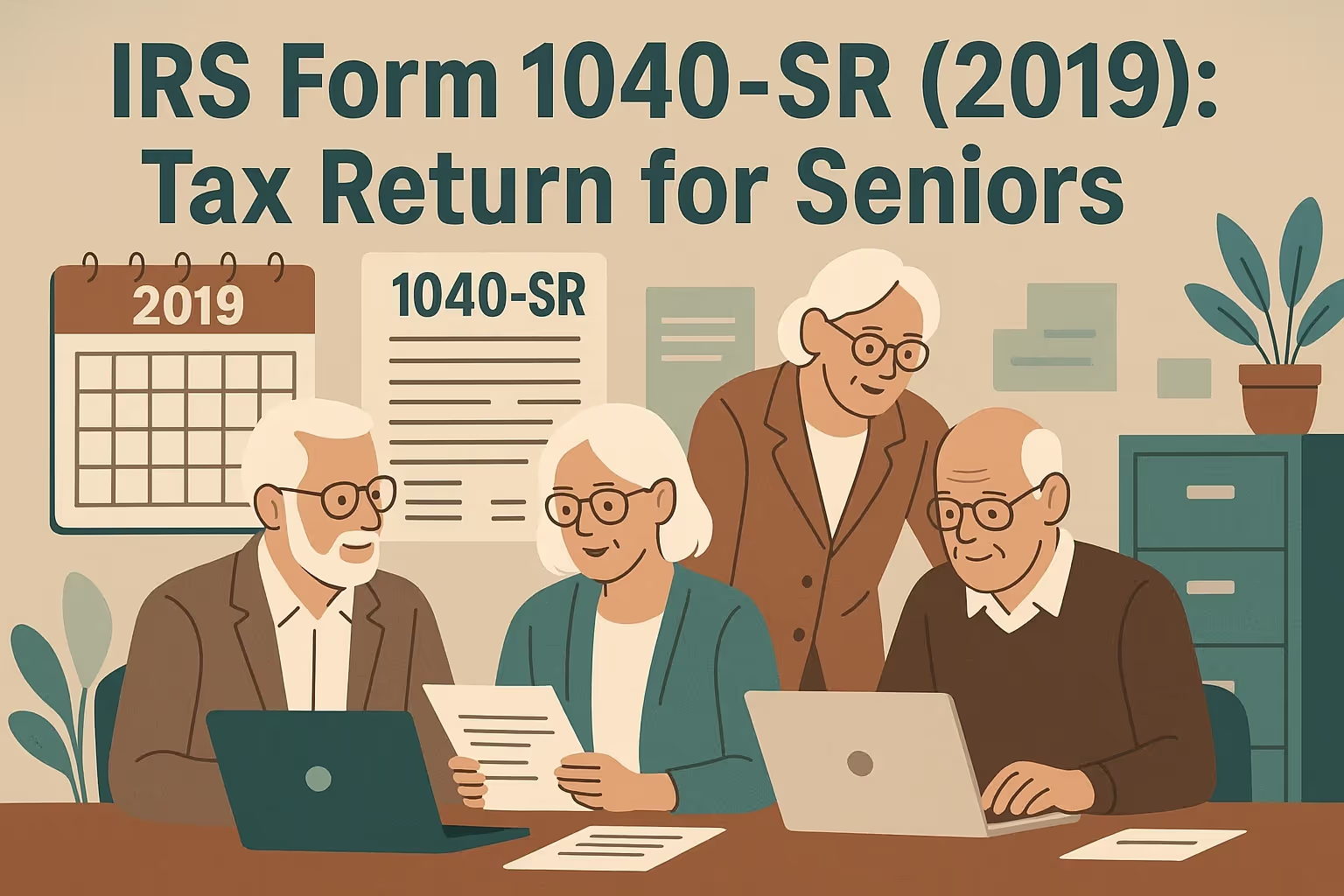Form 1040SR 2023 Instructions: Senior Tax Filing Made Easy
Filing federal taxes often feels complicated, particularly for retirees juggling income from Social Security, pensions, or personal savings. To simplify the process, the IRS developed Form 1040-SR, a senior-friendly version of the standard Form 1040. It features larger print, an easy-to-follow layout, and a built-in standard deduction chart, allowing older taxpayers to see their deduction amounts at a glance without using separate worksheets.
This comprehensive guide explains the instructions for Form 1040SR 2023 in clear, practical steps. You’ll learn who qualifies for the form, which documents to collect, and how to report income, deductions, and credits correctly. The guide also covers filing methods—whether you prefer e-filing for speed or mailing a paper return for recordkeeping—and offers tips to prevent common errors.
All details are drawn directly from IRS Form 1040-SR instructions and 2023 IRS publications, giving you a reliable, easy-to-understand roadmap for filing your senior tax return accurately and confidently.
Understanding IRS Form 1040-SR
Form 1040-SR, officially known as the U.S. Tax Return for Seniors, is the IRS’s simplified version of Form 1040. It was introduced to make federal tax filing easier for taxpayers age 65 and older.
This form allows seniors to report income, claim deductions, and calculate taxes using the same rules as the standard Form 1040—but in a more straightforward and easier-to-read layout.
What is Form 1040-SR?
Form 1040-SR serves the same purpose as Form 1040 but is formatted to help seniors complete their tax return with less strain. It includes:
- Larger print and clearer design: The form uses bold headings and more space between lines, reducing visual clutter.
- An on-form standard deduction chart: This helps taxpayers quickly determine their deduction without searching separate instructions.
- The exact schedules and attachments: You’ll still use Schedules 1–3 and other relevant forms if you have additional income, tax credits, or deductions to report.
Who Can Use Form 1040-SR
You can use this form if you were born before January 2, 1959, meaning you were at least 65 at the end of the 2023 tax year. Income type does not limit eligibility—you can file with wages, Social Security benefits, pensions, or self-employment earnings. Married couples may file jointly even if only one spouse meets the age requirement.
Key Advantages for Seniors
Form 1040-SR offers several benefits tailored to older taxpayers:
- Easier to read and complete: The large print and straightforward structure help prevent errors.
- More apparent deduction reference: The built-in standard deduction chart ensures you apply the correct amount based on age, filing status, and blindness.
- Fully compatible with other IRS schedules: You can attach forms used with Form 1040, including Schedules A, B, or D.
For more details on the form’s structure and instructions, visit the IRS page on Form 1040 and Form 1040-SR.
What’s New for 2023
Each new tax year adjusts deductions, credits, and filing options. For 2023, the IRS increased key amounts to reflect inflation and expanded electronic filing choices that simplify how seniors prepare and submit their returns. These updates may reduce taxable income and improve refund outcomes for older taxpayers using Form 1040-SR.
Updated Standard Deduction Amounts
The standard deduction amounts increased for all filing statuses. Seniors 65 and older receive an extra deduction, which lowers their taxable income and may reduce the total tax owed.
- Base Standard Deduction (2023): $13,850
- Additional Amount (Age 65+ or Blind): + $1,850
- Total Possible Deduction: $15,700
- Base Standard Deduction (2023): $27,700
- Additional Amount (Age 65+ or Blind): + $1,500 per eligible person
- Total Possible Deduction: Up to $30,700 (if both spouses are 65+)
These updated standard deduction amounts apply automatically when you check the age or blindness boxes on Form 1040-SR.
Credits and Filing Updates for 2023
- Clean Vehicle Credit: Expanded to include new and previously owned electric vehicles.
- Child Tax Credit: The refundable portion increased to $1,600 per qualifying child.
- E-Filing Enhancements: More seniors can use Free File and direct IRS e-filing tools.
- Direct File Pilot: Available in select states, allowing qualified taxpayers to file their tax return directly with the IRS.
These updates make the 2023 filing process more straightforward, faster, and beneficial for senior taxpayers.
Before You Start: Filing Status and Documents
Before completing Form 1040-SR, confirm your filing status and gather all necessary documents. Starting with the correct information reduces mistakes, saves time, and ensures the accuracy of your tax return.
Choose the Correct Filing Status
Your filing status determines your standard deduction, tax rate, and eligibility for specific tax credits. The IRS recognizes five main categories:
- Single: You were unmarried or legally separated as of December 31, 2023.
- Married Filing Jointly: You and your spouse combine income and deductions on a single return.
- Married Filing Separately: Each spouse files a separate return, usually to maintain individual responsibility for taxes owed.
- Head of Household: You were unmarried and paid more than half the cost of maintaining a home for a qualifying dependent.
- Qualifying Surviving Spouse: You may use this status for up to two years after your spouse’s death if you have a dependent child.
Gather Your Documents
Having complete records helps you prepare your tax return accurately and report every source of income. Use the list below as your starter checklist.
- Forms W-2. These forms report wages and the federal and state taxes withheld during the year.
- Forms 1099. These statements report interest, dividends, pensions, IRA distributions, and other additional income you must include.
- Form SSA-1099. This form shows the total Social Security benefits you received for the year.
- Form 1098. This statement reports mortgage interest and, in some cases, property tax payments that may support deductions.
- Receipts and statements. To substantiate claims, keep proof of medical expenses, charitable donations, and other deductible costs.
- Prior-year return and IP PIN. Include your filed return from the previous year and your Identity Protection PIN, if the IRS issued one.
Gathering these documents before you start helps you claim every eligible deduction and avoid delays when filing your Form 1040-SR
Step-by-Step: Completing Form 1040-SR
Follow these steps to complete Form 1040-SR accurately. Keep your forms, receipts, and prior-year return nearby. The guidance aligns with Form 1040SR 2023 instructions and uses plain, direct language.
1) Personal Information
- Enter names and Social Security numbers exactly as shown on your cards, because mismatches can delay your tax return.
- Please use your current mailing address and update the unit or apartment number if it has changed during the year.
- If filing Married Filing Jointly, list the same primary taxpayer as in prior years to avoid processing issues.
- Check the Presidential Election Campaign box only if you choose to contribute, since it does not change your taxable income or refund.
2) Standard Deduction
- Use the standard deduction table directly on Form 1040-SR to add the age and blindness amounts for you and, if applicable, your spouse.
- If you had significant medical expenses, mortgage interest, or state and local taxes, compare the standard deduction to Schedule A itemized deductions.
- Choose the higher amount, because selecting the optimal method reduces taxable income and can increase your refund.
3) Report Income
- Report wages from all Forms W-2 and attach copies if tax was withheld, because the IRS requires proof of withholding.
- Enter interest and dividends; add Schedule B if totals exceed $1,500 or if you held foreign accounts.
- Report IRA distributions, pensions, and annuities from Forms 1099-R, and include only the taxable portion on the appropriate lines.
- Enter Social Security benefits using Form SSA-1099 and the worksheet to determine the taxable amount.
- Report capital gains and losses on Schedule D with Form 8949 if you sold investments or property.
- Include additional income on Schedule 1 (unemployment, gambling winnings, or hobby income) so your return remains complete.
- Answer the digital assets question and report virtual currency transactions, because sales or exchanges are taxable.
- Report business income on Schedule C and file Schedule SE if applicable, since self-employment tax may apply.
4) Adjustments, Credits, and Other Taxes
- Use Schedule 1 for adjustments such as student loan interest, IRA deductions, HSA deductions, or self-employed health insurance.
- Claim tax credits on Schedule 3, including education and foreign tax credits, because credits reduce tax dollar for dollar.
- Use Schedule 2 for other taxes, including self-employment tax, Alternative Minimum Tax, and repayments such as the Premium Tax Credit.
5) Tax Calculation and QBI (if applicable)
- Subtract your deduction from income to arrive at taxable income, and then use the IRS Tax Table or the computation worksheet as directed.
- If you have qualified business income, complete Form 8995 or 8995-A to determine the QBI deduction, and carry the result to the correct line.
- Verify withholding and estimated tax payments so your balance due or refund reflects all prior payments.
6) Review, Refunds, and Signatures
- Recheck math, names, SSNs, and bank details for direct deposit, because minor errors can delay refunds.
- Attach the required forms with withholding on the left side of a paper return, and include all schedules referenced in your lines.
- Sign and date the return; if filing jointly, ensure both spouses sign.
- Keep a complete copy with supporting documents for your records, and save your e-file confirmation or mailing receipt for proof of filing.
How to File: E-File or Paper
How you submit your tax return affects speed, accuracy, and tracking. Choose the option that best fits how you manage your records and your comfort level with technology.
E-File Options
If you qualify, electronic filing works online through IRS-approved software, a tax professional, or Free File. E-filing reduces math errors with built-in checks, provides immediate acceptance confirmation, and speeds refunds through direct deposit. Many providers allow secure document uploads, which simplifies organizing documents. Seniors who prefer in-person help can use VITA/TCE sites, where certified volunteers can prepare and e-file returns at no cost to eligible taxpayers.
Paper Filing
A paper return suits filers who want physical copies, prefer a pen-and-paper review, or have limited internet access. Assemble required schedules and other forms, attach W-2 and 1099 copies that show withholding, and sign and date the return; both spouses must sign for Married Filing Jointly. Mail the package to the address listed for your state and consider a trackable service. If you owe, include Form 1040-V or pay online, and keep complete copies for comparisons from prior years.
Schedules and Attachments You Might Need
Some returns require schedules or other forms in addition to Form 1040-SR. Attaching the right items helps you calculate the correct tax, claim deductions, and receive any tax credits you qualify for.
Common schedules for seniors
These schedules appear most often on senior returns. Review your income and expenses to see which apply.
- Schedule A (Itemized Deductions): Use this if itemized medical expenses, mortgage interest, or state and local taxes exceed your standard deduction.
- Schedule B (Interest and Ordinary Dividends): File this if your interest or dividends exceed $1,500 or if you have foreign accounts.
- Schedule D (Capital Gains and Losses): Include this if you sold investments or property and must report gains or losses.
- Schedule R (Credit for the Elderly or the Disabled): Claim this tax credit if you meet the age and income rules.
- Schedules 1–3: Use these for additional income, adjustments, other taxes, and nonrefundable or refundable credits.
Other forms to watch
Certain situations require extra documentation. Gather details from prior years if needed.
- Form 8889 (HSA): File this if you had Health Savings Account contributions or distributions.
- Form 8962 (Premium Tax Credit): Attach this if you used Marketplace insurance and received advance credits.
- Form 5329 (Retirement Plans): Use this to report early distributions or missed RMD-related taxes.
- Form 2441 (Child and Dependent Care Expenses): Complete this if you paid for qualifying care and meet the requirements.
Avoid These Common Errors
Mistakes can delay refunds or trigger IRS notices. Form 1040-SR is an easier-to-read version of Form 1040, but accuracy still matters for a clean tax return.
Frequent mistakes to watch for
- Filing status and deduction boxes: Choosing the wrong status or missing the age/blindness boxes can affect your tax deductions and increase your tax bill.
- Assuming different rules for 1040-SR: Seniors sometimes think 1040-SR has unique rules, but it uses the exact schedules and attachments as Form 1040.
- Missing attachments: Paper filers often forget W-2s, 1099s, or other required documents, which can stall processing.
- Overlooking credits: Filers sometimes skip education credits for themselves or dependents, leaving money on the table.
- Income reporting errors: Common issues include misreporting the taxable portion of Social Security or omitting small 1099-INT or 1099-DIV amounts.
- ID and banking mistakes: Transposed Social Security or routing numbers can delay refunds or cause rejection.
Prevention tips
- Match method to your situation: Compare standard versus itemized amounts and use worksheets appropriate to your tax situation.
- Build a review habit: If you prepare your taxes, use software checks or a written checklist, then recheck math, signatures, and totals before filing.
Special Situations for Seniors
Some filing situations are everyday for older taxpayers and need extra care. Addressing these early helps you avoid delays and unnecessary notices.
Social Security only or low income
You may not need to file if Social Security is your only income. When you have other income, part of your benefits may be taxable. Utilize the worksheet to complete the taxable portion accurately. Compare documents with previous years to spot changes, such as new pensions or withholding. If excess tax was withheld, an overpayment created by withholding could produce a refund. If unsure, you can call the IRS or visit a local office for help.
RMDs and retirement income
Required Minimum Distributions (RMD) begin at the applicable age for most plans. To avoid penalties, confirm custodian records and dates for RMDs. For example, Roth IRA distributions are usually tax-free if the rules are met. Pensions, annuities, and IRA withdrawals may be subject to tax based on previous contributions.
Being claimed as a dependent
If someone can claim you, your standard deduction may be limited. Confirm support and income thresholds and coordinate with the other filer. Check whether medical expenses, property taxes, or charitable gifts are better claimed on your return or theirs to maximize overall savings.
First-Time Filer Tips
Filing for the first time after age 65 can feel new, even if you handled taxes before retirement. A simple system and clear choices will make the process smoother and more accurate.
Getting Organized
Create one paper or digital folder for this year’s return, and keep income forms separate from deduction support.
- Save receipts and other documents that support medical expenses, charitable gifts, and property taxes, because they may increase deductions.
- Keep a one-page checklist of every form you expect, and mark items off only after you verify amounts.
- Compare last year’s return to spot recurring entries and carryovers, such as capital loss carryforwards.
Choosing Help
Based on your comfort and complexity, decide whether to use software, a professional, or a volunteer site.
- If you do your taxes, choose reputable software that provides step-by-step guidance and error checks.
- Hire a CPA or enrolled agent if you have multiple income sources or state filing questions.
- As you complete the return, match each amount to a form and confirm names, SSNs, and bank details before submission.
Recordkeeping and Next-Year Prep
Good records make filing easier and help resolve questions if the IRS contacts you. Create a simple system—paper or digital—and store all tax forms and support in one place you can access quickly.
What to Keep and How Long
- Keep your filed tax return and all supporting documents for at least three years after the filing date.
- Retain records for loss claims (such as worthless securities or bad debts) for up to seven years.
- Keep basis records for investments and property until you sell the asset and the limitation period expires.
- Store proof of deductible expenses, including medical bills, property tax receipts, mortgage interest, and charitable acknowledgments.
Planning Ahead
- Review withholding and estimated tax payments midyear to avoid large balances or unexpected refunds.
- Track medical expenses, charitable gifts, and investment activity throughout the year rather than at tax time.
- Note key dates for RMDs, quarterly estimates, and document arrivals, and add reminders to a calendar.
- Save this year’s completed return as a template for next year’s organization.
Key IRS Resources (2023)
When linking, always describe the destination page. Avoid generic phrases like “click here,” and match the anchor to the official page title or topic.
- Form 1040-SR Instructions (2023): Provides line-by-line explanations, deduction limits, and worksheets for seniors filing Form 1040-SR.
- Publication 554 — Tax Guide for Seniors: Covers Social Security benefits, retirement income, and common tax credits available to older adults.
- Schedules for Form 1040: This section explains when to file Schedules 1–3 and what each schedule covers. For full details, visit the official IRS page on Schedules for Form 1040.
- IRS Free File: Eligible taxpayers can prepare and e-file their federal returns online at no cost.
- Where’s My Refund? and IRS Payments: Use these IRS tools to track refund status and make secure payments through Direct Pay or EFTPS.
Conclusion and Next Steps
Form 1040-SR makes filing clearer for seniors while using the same tax rules as Form 1040. With larger print and a built-in standard deduction chart, you can prepare an accurate tax return with less strain. Use this guide to stay organized and avoid common errors.
- Gather documents and confirm your filing status before you start.
- Fill the form step by step, and review every entry for accuracy.
- Compare the standard deduction with itemized amounts, and choose the higher.
- File electronically for speed, or mail a complete paper package.
- Track your refund and manage any payments using official IRS tools.
Save a complete copy for your records. If you need help with your own taxes, contact a tax professional or visit a VITA/TCE site.
Frequently Asked Questions (FAQs)
What is the difference between Form 1040 and Form 1040-SR for my tax return?
Form 1040-SR is designed for filers age 65 or older and mirrors Form 1040 line by line. It uses larger print and includes a standard deduction chart on the form, but the rules, schedules, and calculations are identical. If you qualify by age, you may use either version. Choose the form that is easier to read, attach all required schedules, and follow the exact instructions you would for Form 1040.
How do senior-specific amounts affect my tax deductions in 2023?
Your deduction starts with the base amount for your filing status and increases if you or your spouse is age 65 or blind. Use the on-form chart to count age or blindness boxes and calculate your total. Then compare that figure to itemized deductions. Choose the method that lowers your tax the most and ensure your filing status and checkboxes match your situation before finalizing.
What types of additional income must seniors report on Form 1040-SR?
Beyond wages, you must report interest, dividends, IRA and pension distributions, capital gains, taxable Social Security, unemployment compensation, and gambling winnings. Business earnings go on Schedule C, and self-employment tax may apply on Schedule SE. Marketplace insurance reconciliations and alimony from older agreements can also appear. Review Forms 1099 and worksheets to place each item on the correct line and avoid missing taxable amounts correctly.
Which medical expenses can seniors deduct on Schedule A?
You can deduct health costs only when itemizing, and the total exceeds 7.5 percent of adjusted gross income. Eligible items include premiums within limits, prescriptions, dental and vision care, specific medical equipment, and necessary travel for treatment. Do not include amounts reimbursed by insurance or paid with HSA funds. Compare itemizing to the standard deduction to determine which method lowers your overall tax carefully and accurately.
How should seniors report virtual currency on Form 1040-SR?
Answer the digital assets question on page one. Report sales, exchanges, or conversions on Form 8949 and Schedule D using cost basis to compute gains or losses. Income from mining, staking, or airdrops is ordinary and belongs on Schedule 1 or Schedule C, depending on the activity. Keep detailed dates, amounts, and wallet records. Transfers between your own wallets without a sale are not taxable events.


















